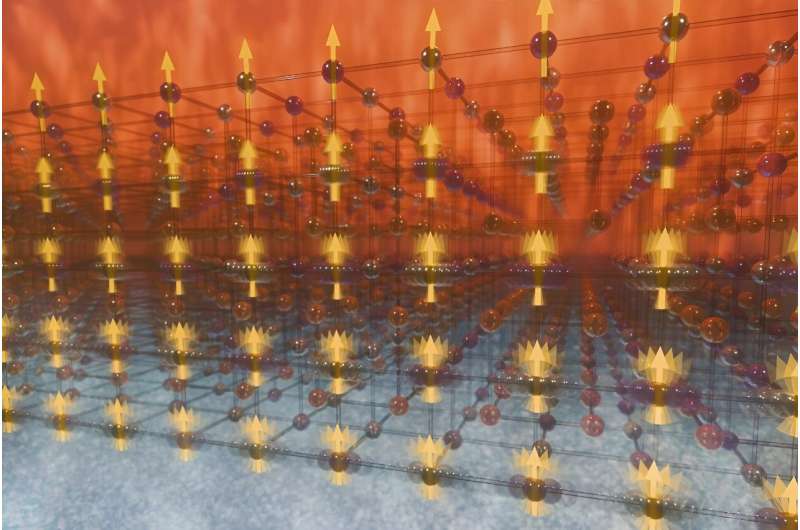
Strong coupling between localized atomic vibrations and spin fluctuations increases heat absorption and release, shown from bottom to top, in a magnetic shape-memory alloy, improving its solid-state cooling capability. Credit: Phoenix Pleasant/ORNL, U.S. Department of Energy
A research team led by the Department of Energy’s Oak Ridge National Laboratory has filled a knowledge gap about how heat moves at the atomic scale. This new understanding holds promise for improving materials to advance an emerging technology called solid-state cooling. The findings are published in the journal Scientific progress.
An environmentally friendly innovation, solid-state cooling could efficiently cool many everyday objects, from food to vehicles to electronics, without using traditional refrigerant liquids and gases or moving parts. The system would operate through a quiet, compact and lightweight system that would allow precise temperature control.
While the discovery of improved materials and the invention of better devices are already helping to promote the growth of this new cooling method, a deeper understanding of the improvements in materials is essential. The research team used a series of neutron scattering instruments to examine at the atomic level a material that scientists consider an optimal candidate for use in solid-state cooling.
The material, a magnetic nickel-cobalt-manganese-indium shape-memory alloy, can be deformed and then returned to its original shape by undergoing a phase transition either by increasing the temperature or by applying a magnetic field. When subjected to a magnetic field, the material undergoes a magnetic and structural phase transition, during which it absorbs and releases heat, a behavior known as the magnetocaloric effect.
In solid-state cooling applications, this effect is exploited to provide refrigeration. One of the key features of the material is its proximity to disordered conditions known as ferroic glass states, as they present a means of enhancing the material’s ability to store and release heat.
Magnons, also called spin waves, and phonons, or vibrations, couple in a synchronized dance in small regions spread throughout the disordered arrangement of atoms that make up the material. The researchers found that the behavior patterns in these small regions, called localized magnon-phonon hybrid modes in the team’s paper detailing the research, have important implications for the material’s thermal properties.
Scientists have revealed that modes cause a significant change or shift in phonons in the presence of a magnetic field. Modes also alter the phase stability of the material. These changes can lead to fundamental changes in the material’s properties and behavior that can be tuned and customized.
“The neutron scattering shows that the cooling capacity of the shape memory magnetic alloy is tripled by the heat contained in these local magnon-phonon hybrid modes that form due to the disorder of the system,” said Michael Manley of ORNL, the study’s lead author. “This discovery paves the way for making better materials for solid-state cooling applications for society’s needs.”
The shape-memory magnetic alloy the team studied is in a phase that has nearly formed disordered conditions known as spin glass and strain glass — not the familiar glass used in windows and elsewhere, but rather unconventional phases of matter that lack order. The magnetic moments, or tiny magnets, associated with atoms in the spin glass phase are randomly oriented rather than pointing in the same direction.
In comparison, in the strain glass phase, the lattice of atoms is constrained at the nanoscale in a disordered and irregular pattern. Spin glass and strain glass are considered frustrated conditions in a material because they result from competing interactions or constraints that prevent the material from reaching a stable ordered state.
“As the material approaches this frustrated state, the amount of stored heat increases,” Manley explains. “The long- and short-range interactions manifest themselves as localized vibrations and spin waves, meaning they are trapped in small regions. This is important because these additional localized vibrational states store heat. Changing the magnetic field triggers another phase transition in which this heat is released.”
Controlling the functions of the magnetic shape memory alloy so that it can be used as a thermal sponge could be a way to enable efficient solid-state cooling without the need for refrigerants or traditional mechanical components.
More information:
Michael E. Manley et al, Hybrid magnon-phonon localization enhances function near ferroic glassy states, Scientific progress (2024). DOI: 10.1126/sciadv.adn2840
Provided by Oak Ridge National Laboratory
Quote: Scientists Probe Chilling Behavior of Promising Solid-State Cooling Material (2024, July 1) Retrieved July 2, 2024 from https://phys.org/news/2024-07-scientists-probe-chilling-behavior-solid.html
This document is subject to copyright. Apart from any fair dealing for the purpose of private study or research, no part may be reproduced without written permission. The content is provided for informational purposes only.